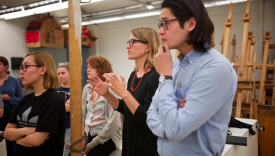Film & Media Studies 387 - How Does Hollywood Work?
M/W | 2:35 PM - 3:50 PM;SU | 7:00 PM - 10:00 PM
(Offered as ENGL 387 and FAMS ) As an industry in the business of making both entertainment and art, Hollywood is a fascinating case study to explore. This course will focus on how contemporary Hollywood works and how understanding its work can enable us also to understand how films “work.” Our first unit will begin by exploring the context of industrial and independent practices through six key examples, which will form the primary models for the course throughout the semester. With some overlap between them, each film will enable us to look at various aspects of movie-making, whether through particular creative roles (e.g., director, screenwriter, director of photography, producer, actors) or through other aspects of production (e.g., studio, genre, location, exhibition). Students will compose an essay that examines 1-2 creative roles in a particular film (or one particular role across two films). The second unit of the course will build on the first, as we will focus on the same set of films, but from a more analytical perspective to emphasize cultural and textual analysis. In this unit, students will therefore have the choice to investigate one of the previous films for further research, ultimately producing an exploratory essay that brings together contextual and textual analysis. The final unit of the course will focus on a final project that considers how we might “pitch” one of our central films for production in Hollywood today. Readings throughout the course will be drawn from popular and academic sources that focus on our central films in relation to the primary roles or fields of inquiry of the respective units. Case studies will likely include the following six films: Die Hard (John McTiernan, 1988), Speed (Jan de Bont, 1994), Something’s Gotta Give (Nancy Meyers, 2003), Creed (Ryan Coogler, 2015), The Rider (Chloé Zhao, 2017), and Everything Everywhere All at Once (Daniel Kwan and Daniel Scheinert, 2022).
Limited to 35 students. Fall semester. Professor Hastie.
How to handle overenrollment: FAMS students have priority. I would be willing to open up 5-10 additional seats, prioritizing FAMS and English majors for those seats.
Students who enroll in this course will likely encounter and be expected to engage in the following intellectual skills, modes of learning, and assessment: emphasis on written work, readings, filmic analysis, peer assessment


